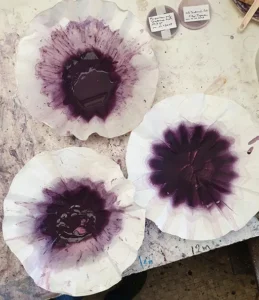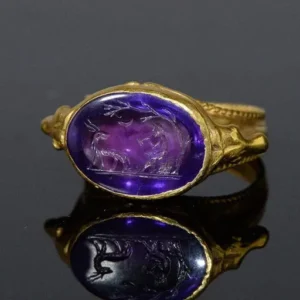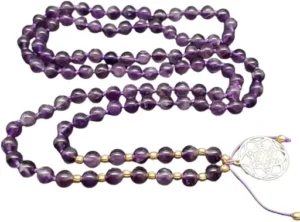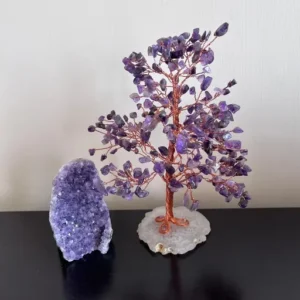
Estimated reading time :
April 19, 2025 5:53 am
Amethyst in Religion & Spirituality: A Gemstone of Legacy
Writer’s Name :
Date of Publishing :
Writer’s Name :
Arya
Estimated reading time :
Introduction
It’s not new that the luxury radiating purple stone also radiates energies that can bring your life back on track! The mystical purple radiance of amethyst crystal has illuminated spiritual practices across civilizations for over 5,000 years, making it one of history’s most revered gemstones. From ancient Egyptian tombs to modern meditation rooms, this royal stone has proudly continued to hold profound spiritual significance.
In this article, let’s discuss what hands the amethysts have been passed down from through centuries.
Christian Traditions
The sacred journey of Amethyst in Christianity began in biblical era, where it was graciously placed on the breastplate of Aaron (High Priest) as one of the twelve precious stones, representing the tribe of Dan. The Catholic Churches embraced amethyst in religion as a symbol of piety and divine authority, with the bishops wearing amethyst rings to symbolize their spiritual wisdom & dedication to the church.
The Phoenician Legacy
In ancient Phoenicia, the creation of the Tyrian purple, an imperial dye, revolutionized the concept of royal colors. This precious dye was extracted from Murex sea snails and it required approximately 10,000 mollusks to produce a single gram of purple dye. The process was labor-intensive, which made the color extremely rare and valuable, establishing purple as the ultimate symbol of wealth and power.

Imperial Purple
The Roman Empire established the royal status of purple with its laws that restricted its use to emperors and higher officials. Wearing of purple without authorization meant very harsh punishment, even death (crazy, I know, right?). This tradition was continued by the Byzantine Empire, which ascribed the title “born in the purple” (porphyrogenitus) to legitimate heirs to the throne- those born to parents already on the throne-in contrast to other contenders.
Sacred and Royal Heritage
During the medieval and Renaissance times, purple remained in its royalty era, worn by authorities of the land and church alike. Popular royal figures, from Henry VIII to Louis XIV, used purple to enforce their claim to political dominion, while the Catholic Church integrated purple in ceremonial vestments as an indication of connection between earthlings & the almighty.
Learn more about the use of purple & what made it a royal stone in this article.
Ancient Roman Beliefs
The Romans used to bestow various powers upon amethyst. Military commanders carried them to stimulate protection and strategic thinking, while married women wore the amethyst gemstone for the harmony of their marriage. Merchants thought it would provide good business sense, for amethysts also supposedly bring prosperity into one’s life.

Buddhist Practices
The Tibetan Buddhist tradition has an excellent meaning for amethyst stone, giving it recognition as a sacred stone for meditation and spiritual advancement, as it is supposed to help deepen meditation. Amethyst in Buddhism is often used in the creation of prayer beads, known as malas, which traditionally speak of 108 beads, together with one special guru bead indicating their relation to the student and teacher.

Cultural Symbolism
Protection and Power
- Several Native American tribes traditionally used amethyst gemstone in healing rituals, considering it a powerful protective stone, often employed to promote spiritual clarity, inner peace, and to connect with the spirit realm during ceremonies; with specific tribes like the Zuni and Navajo incorporating it into their practices.
- Egyptian soldiers, 1000s of years before roman empire’s existence, also wore amethyst amulets in battle as well as was adorned by the elites in their jewelry. Ancient Egyptians also believed that wearing amethysts would help them in their afterlife.
- Chinese feng shui practices, a concept similar to the Indian concept of Vastu Shastra, use it to dispel negative energy, enhance spiritual awareness, create calming environments & promote wealth especially when placed in the southeast corner.

While both Feng Shui and Vastu Shastra aim to create harmonious living spaces by aligning with natural energies, the key difference lies in their origins, focus on architectural design versus object placement, and the specific elements they prioritize: Vastu Shastra is an ancient Indian system primarily focused on the design and layout of a building itself, emphasizing the balance of natural elements within the structure, while Feng Shui is a Chinese practice that focuses more on the placement of objects within a space to influence the flow of positive energy, taking into account seasonal changes and the five elements (wood, fire, earth, metal, water) in a more flexible way.
Healing and Transformation
Different cultures attribute various healing properties:
- The Persian culture viewed amethyst gemstone as a powerful protective stone that guards against evil thoughts and negative energies. Ancient Persian healers believed the stone could dissipate negative thought patterns, enhance mental clarity and wisdom, protect against psychic attacks & promote pure thoughts and spiritual growth.
- The Greeks’ relationship with amethyst was deeply rooted in sobriety and mental clarity. Amethyst comes from the word “amethystos” which literally means “not intoxicated” in Ancient Greek. The legend goes like this – Dionysus (god of wine), raged by the insult of a human ordered his tigers to kill any human that comes by. Amethyst, a young maiden was on her way to worship the goddess Diana and to save Amethyst from Dionysus’ wrath, Diana turned Amethyst into a pure white quartz statue. Upon realisation of his mistake, Dionysus cried wine tears that felt on the statue, staining it reddish purple, from where the color of amethyst comes. Hence dating back to 320 BC, Greeks believed wearing amethyst would prevent drunkenness. Wealthy Greeks would also drink from amethyst vessels to maintain sobriety. Read more about the history here.
- In Celtic traditions, amethyst crystal was valued for its mystical and prophetic qualities. Celtic seers used amethyst to enhance their prophetic visions, as they believed amethyst will strengthen their spiritual awareness and insight. Known as the “stone of spirituality,” amethyst was also used in spiritual rituals aimed at deepening wisdom.
- Amethyst in Hinduism, since the Indian Ayurvedic tradition, was valued for its balancing properties. It has been used to calm the mind and reduce mental stress & promote emotional equilibrium. The purple stone since back then has been applied in practices for reducing anxiety and restlessness & is considered beneficial for balancing the crown chakra and promoting higher consciousness. Read more about chakras & the influence of gemstones in this article here.
- 1. Geographical origin: The origin place of the stone plays a huge role in its pricing. It can significantly raise the stone’s price if it's a Siberian or Brandberg amethyst.
- 2. Color : Amethysts that have a more deep and uniform color are more valuable than the rest.
- 3. Clarity: Amethysts that are eye-clean and have no visible inclusions are also priced highly.
- 4. Market demand: Market trends play a huge role in the pricing of any stone. Amethyst is however a stone that is always in trend because of its rich color and its healing properties. #always_in_demand
- 5. Carat: Larger the stone, the more valuable it is.
Spiritual Benefits of Amethyst
Modern interpretations of these ancient beliefs continue to influence how amethyst is used in alternative healing practices today. It’s important to note that although these properties are based more on traditional beliefs, certain physical properties also support scientific evidence for this same. Read about Amethyst’s metaphysical properties in this article.
Contemporary spiritual practitioners associate amethyst with:
- Enhanced intuition
- Dream interpretation
- Stress relief
- Emotional balance
- Creative inspiration
This rich tapestry of beliefs and traditions continues to influence how amethyst is perceived and used in modern spiritual practices, making it one of the most culturally significant gemstones in history.
You may also like


